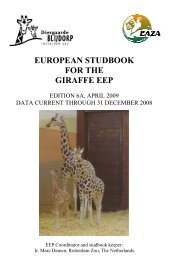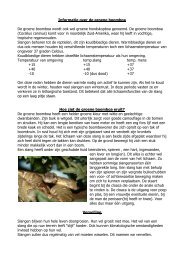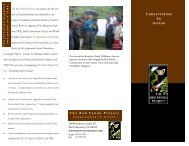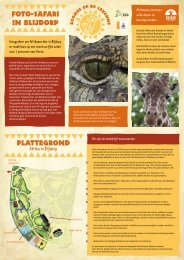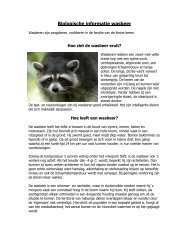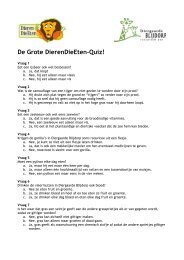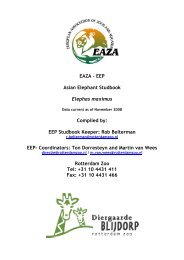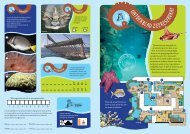You also want an ePaper? Increase the reach of your titles
YUMPU automatically turns print PDFs into web optimized ePapers that Google loves.
EUROPEAN STUDBOOK CROWNED PIGEONS<br />
5.4 Housing conditions<br />
Crowned pigeons are not reproducing very well in captivity. Due to a lack of knowledge of the<br />
ecology of crowned pigeons in the wild there is a lot of variation in husbandry in the different<br />
institutions. For that reason it is investigated under which circumstances crowned pigeons are kept<br />
in captivity and if they are reproducing or not. There also has been contributed a research project in<br />
Papua New Guinea. The complete researches can be found in the European <strong>Studbook</strong> of Crowned<br />
Pigeons number 4. In this paragraph only a summary of the conclusions of the ex situ research will<br />
be given.<br />
Ex situ research project<br />
The research project was carried out in four public institutions: Amsterdam Zoo (Artis), Rotterdam<br />
Zoo (Blijdorp), Arnhem Zoo (Burgers Zoo) and Alphen a/d Rijn Bird park (Avifauna). If Burgers<br />
Zoo is considered to be the most natural situation in captivity, it can be concluded that a restriction<br />
in the variation in the enclosure, leads to an increase in care behaviour: the crowned pigeons spend<br />
more time preening their feathers and so on. If the environment of the birds is even more restricted,<br />
the birds also spend more time conducting metabolic behaviour. Time budget in this case is a<br />
measure for wellbeing.<br />
The enclosure also needs to have as many different elements as possible to enable the birds<br />
to conduct the behaviour they want. From the project into preferences for a type of substrate it<br />
turned out that crowned pigeons needed both sand as well as mould. They use the sand to conduct<br />
care behaviour (preening) and the mould to conduct foraging. If there is no mould and only sand,<br />
they start preening that much, that the plumage gets damaged. By supplying the birds with some<br />
parts of mould (preferably planted), the foraging behaviour increases, the behaviour in time<br />
decreases and the birds are more active and also more attractive to the visitors, and the enclosure<br />
looks more ‘natural’ to the visitors. The mould can be separated from the sand with use of trunks.<br />
If watered regularly the maintenance of the mould does not cost more time than the sand.<br />
This research project mainly focused on the use of substrate and the preference for a type of perch.<br />
Two out of six pigeons preferred a thick perch. Also changes in substrate did not result in the<br />
expected change in behaviour. One of the major conclusions, which can be drawn from this<br />
experiment, is that crowned pigeons are very susceptible for changes in their environment. They<br />
are used to the daily routine of the keepers, but as soon as something unexpected happens, like<br />
catching other birds or replacing some shrubs, they need several days or more to behave like they<br />
did before. Also the replacement of perches or substrate caused a lot of stress and it became<br />
necessary to wait for days before observing the birds, to get comparable results. But this still<br />
influences the reliability of the results.<br />
Crowned pigeons are typical ground dwellers and the best is to keep them solitary, eventually with<br />
some other small species, which lives in the trees, because they can be very aggressive. To get<br />
them incubating an egg, there should not be any other large birds in the aviary. For example<br />
turacos and kookaburras are that curious and cheeky that they start emptying the nest if they have<br />
the possibility.<br />
Although, crowned pigeons kept under the most natural circumstances in the Netherlands<br />
(Burgers Zoo) have a preference for thin perches (diameter maximum 3 centimetres) to rest and<br />
sleep on, in this research project it could not be proved that also other crowned pigeons have a<br />
preference for thin perches.<br />
166



